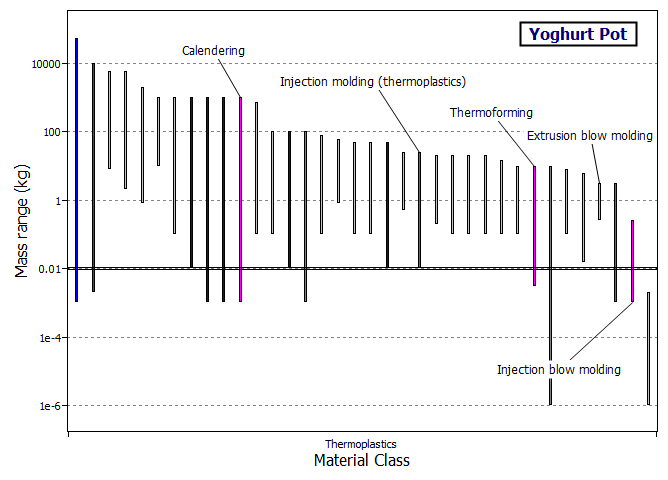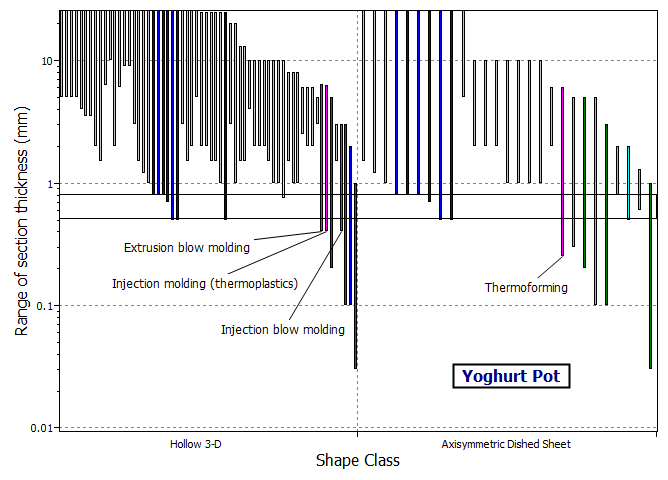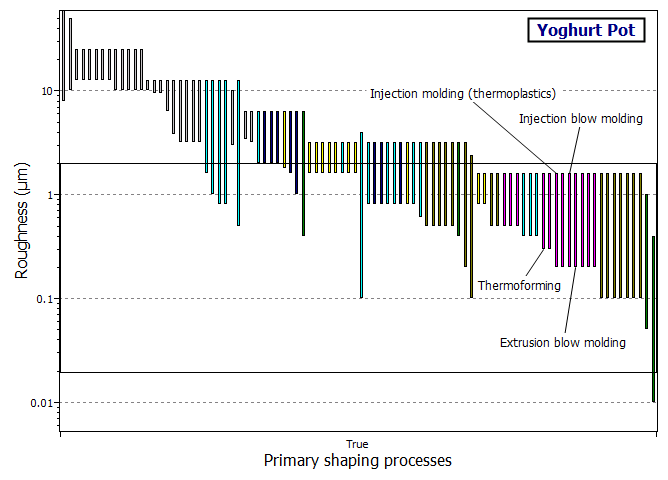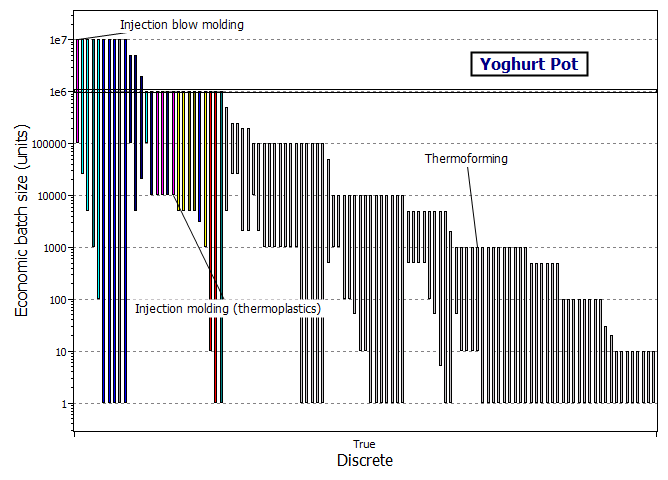
The plastic yoghurt pot, a common feature of everyday life, is made from either polystyrene or polypropylene. The shape, shown in Figure 1, could be described either as a dished sheet or as a 3-D hollow shape depending on the starting form of the material (sheet or pellets, respectively). A typical pot weighs about 10 g, and has a section thickness in the range 0.5–0.8 mm. The surface of the pot should be smooth — without having to resort to secondary operations – so as to make it appealing to customers. And, of course, it should be made very cheaply. Which process can be used to make it?

Figure 1. A Yoghurt Pot
The design requirements for the yoghurt pot are listed in Table 1.
| Material Class | polymer (thermoplastic) |
| Process Class | primary, discrete |
| Shape Class | axisymmetric-dished-sheet or 3-D hollow |
| Mass | 0.01 kg |
| Minimum Section (thickness) | 0.5 – 0.8 mm |
| Surface Finish (Roughness) | 2 μm or better |
| Batch Size | 1,000,000 |
Table 1. Yoghurt pot: design requirements
Figures 2–6 show the selection. Figure 2 shows the first of the selection stages: a bar chart of mass range against material class. Thermoplastic polymer was selected from the material class menu. The selection box for the pot is placed at a mass of 0.01 kg. Many processes pass this stage.

Figure 2. A chart of mass range against material class. The box isolates processes which can shape thermoplastic polymers and can handle the desired mass range.
We next seek the subset of processes which can produce the shape (described as either 'dished-axisymmetric-sheet' or '3-D hollow') and the desired section thickness. The corresponding chart is divided into two sections corresponding to each shape (Figure 3). The selection box specifies the requirement of a section thickness in the range 0.5 to 0.8 mm.

Figure 3. A chart of section thickness range against shape class. The chart identifies processes capable of making both dished-axisymmetric-sheet and 3-D hollow shapes with sections in the range 0.5 to 0.8 mm.
The next selection stage is shown in Figure 4. It is a bar chart of surface roughness against process class selecting 'primary shaping processes' from the process class menu. The selection box specifies a surface finish requirement of 2 μm or better. This is a relaxed requirement of which many polymer processes are capable (as seen in the figure).

Figure 4. A chart of roughness against process class. The box isolates primary shaping processes which are capable of roughness levels of 2 μm or better.
One further step is required in order to identify the processes which can produce the pot cheaply. The appropriate chart is that of economic batch size against process class. Only discrete processes are plotted on the chart. The selection box specifies a batch size of 1,000,000. Processes which have passed all the previous selection stages are labeled. The ones which are economic for a batch size of 1,000,000 are listed in Table 2. Figure 6 shows the chart.

Figure 5. A chart of economic batch size against process class, for a batch size of 1,000,000 pots. The labeled processes are the ones which passed all previous stages.
| Injection blow molding |
| Injection molding – thermoplastics |
Table 2. Processes for making the yoghurt pot
Three processes are capable of making the pot. They are: injection blow molding, injection molding, and thermoforming. At such a large production volume, injection blow molding and injection molding emerged as the most economic ones. Commercially, some yoghurt pots are injection-molded (these can be identified by the injection sprue left at the base of the pot).
For a cheap, mass-produced pot, near-net shape processes have an important advantage in creating less scrap. The final selection rests with more detailed cost analysis of these.